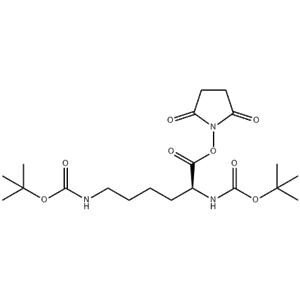Peptide Synthesis and Modification: Boc-L-Lys(Boc)-OSu plays a crucial role in solid-phase peptide synthesis, allowing researchers to elongate peptide chains or introduce specific modifications. These modifications can enhance the stability, solubility, or bioactivity of peptides, making them more suitable for biological studies or therapeutic applications.
Protein Engineering and Conjugation: Boc-L-Lys(Boc)-OSu can be used to conjugate peptides or other moieties to proteins, providing a means to introduce new functionalities or modify protein properties. This technique is useful in protein engineering, where researchers aim to enhance protein stability, activity, or targeting capabilities. Drug Design and Discovery: The ability to precisely control the structure and function of peptides makes Boc-L-Lys(Boc)-OSu a valuable tool in drug design. By incorporating specific amino acid sequences or modifications, researchers can develop peptide-based drugs that target specific biological processes or diseases. Biomaterial Development: Boc-L-Lys(Boc)-OSu can also be employed in the preparation of functional biomaterials. These materials, which may include hydrogels, scaffolds, or coatings, can be designed to interact with biological systems in a desired manner, making them useful in tissue engineering, regenerative medicine, and other biomedical applications. Biological Probing and Imaging: The fluorescent or labeling properties of Boc-L-Lys(Boc)-OSu can be exploited for biological probing and imaging applications. This reagent can be used to label specific proteins or peptides, enabling their visualization and tracking within biological systems. | 

 China
China

